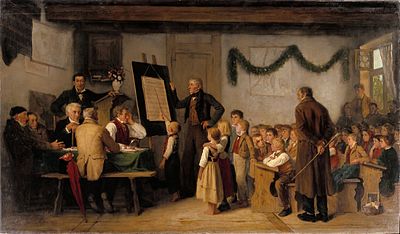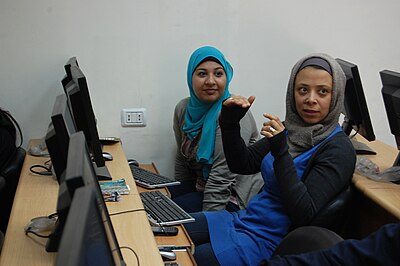Art Appreciation and Techniques/Course guide/Ways to engage
| Art Appreciation and Techniques (#OERuART100) | |
|---|---|
| Course guide | Welcome_and_outcomes | Ways to engage | Links to art resources | Assignments | Links to units and assignments | Development team |
Ways to engage with this course
In contrast to typical first-year university level courses, you are invited to engage with this course for any reason in any way you wish. Here are a few possibilities:
For your own interest and enjoyment
Read all or any part of it at your own pace, in whatever order you want, for your own enjoyment and learning.
- Challenge yourself with any or all of the activities and assignments.
- Join with others in a small class either locally or online to work together and share your work and explorations with others. Maybe you can find an art teacher, local artist, someone who works at an art gallery, or another community volunteer to work with you to develop your study group.
- Share your thoughts and interact with other learners by posting comments on your blog, forums or microblog posts. Remember to include "#OERuART100 in Twitter posts or "OERuART100" as the label or tag in your blog posts.
For possible credit

- Study the course more formally, setting up a study schedule that fits your lifestyle and circumstances, and work through the activities and assignments.
- You may do the written activities, using either a notebook or word processor, or else a blog or wiki if you would like to develop your work online. Other tools such as e-portfolios may be available to you, depending on your circumstances.
The important thing at this point is to do your coursework in such a way that, if you wish to seek credit, you are able to show your completed coursework and demonstrate that the work is your own and not copied from or written by someone else.
- Approach an OERu partner college or university that may be willing to consider your work for credit. That college or university may require additional work such as an exam, along with submission of your assignment work, and may contact you to verify your identity and ensure that the coursework you submitted is your own.
For helping to improve the course
This course as it stands is only a beginning. It has already gone through several revisions since it its original release, and the course designers and editors would like to see it continue to improve. For example, we would like to see:
- More examples of art from different cultures around the world.
- Ideas for revisions or additional content.
- Adaptations or translations for different contexts.
- New ideas for learning activities and assessments.
As this is an OERu course, if you sign up as a WikiEducator member, you can make comments or suggestions under the "Discussion" tabs on each of the course pages. Please note that, as in Wikipedia, changes are monitored and will be reviewed for their appropriateness according to OER community protocols. This is a live OERu course, so please refrain from making substantive changes to this iteration without discussing them on the talk page. You are most welcome to make a copy in WikiEducator, should you wish to make substantive revisions for use in your own context.
Your feedback is welcome. There is a feedback questionnaire at the end of the course that you are invited to complete.
For making your own course
All the materials in this course are licensed under Creative Commons to remix and reuse in any way that you wish. This means that you can take some or all of these course components and and reuse or adapt them to your own context and needs. If you do so, however, you must adhere to the Attribution and Share-Alike requirements of the Creative Commons licences under which this content has been developed and assembled.
For recording, publishing, and sharing your coursework
As you work through the course, you will need space to make notes for your thoughts, reflections, and review. Also, you will need to write down your responses to learning activities and assignments, both for your own use and, if desired, for collaborating with others or submitting your work for formal assessment.
There is a broad range of ways to achieve this. For example, you can use word processing software, notebooks, sketch pads, presentation software, diaries, and e-portfolios. You may also wish to publish your work openly for others to see and comment on. Blogs (web logs) are particularly useful for this purpose. You may wish to look at this resource on how to use a blog. You may want to start and develop a wiki and invite others to add to it.
For communicating with others
If you are studying this course along with a larger group, or in more formal class setting, you may have opportunities to share ideas and collaborate with these learners in addition to the open online students. There are a number of tools that you can use for this purpose. If you wish to collaborate with others in developing projects or other content, tools such as Google Docs or wikis are good for this purpose.
Microblogging (e.g. Twitter) may also be used for communicating with other students. Here is a brief lesson on how to use this tool. Please note that this link takes you into another course so you'll need to remember where you left off in this one.
A note to the course faculty member/leader/volunteer:
You, as an educator, are invited to adopt or adapt this course for your own use. Possibilities include a traditional face-to-face classroom, a blended or online educational setting, and a community setting. A group of students may work through the course as a cohort and collaborate on activities and assignments. The structure of these forms of engagement is up to the skills and experience of the educational leader.
Thus, you will notice that in this course there are no instructions on how these activities may be implemented for individuals or groups. The learning activities embedded in the course materials are ungraded and may be used for practice and/or for helpful student feedback but are not designed to be used for formal grading or learning assessment.
Learners may come from any place and situation in the world. Some may need assistance with tools for conducting their activities and assignments, ranging from basic notepads to blogs, wikis, and e-portfolios. A key consideration is to keep in the forefront the digital skill levels and technology access of the learners.
If you are with an institution that is considering giving credit for this course, the assignments can be used for formal grading. The assignments have been weighted to assist students. There is no grading guide, since faculty members who undertake the evaluation will be able to apply their own judgment in this area. It will be up to the institution to verify the identity of the student and the originality of the submitted work. Options for additional verification may include providing your own exam(s) or other assessments in addition to the assignments given in the course and/or asking students to submit evidence of having completed the coursework (drafts, notes, journals, portfolio pieces, etc.).
Any suggestions for improvements to this course are welcome. Thanks to the Creative Commons license, you are free to adapt, reuse, remix, repurpose and translate this course for any other purposes that meet the needs of your institution or learners, just as we have done. Feel free to pass it on.
Please contact a member of the course development team with your suggestions or ideas.

